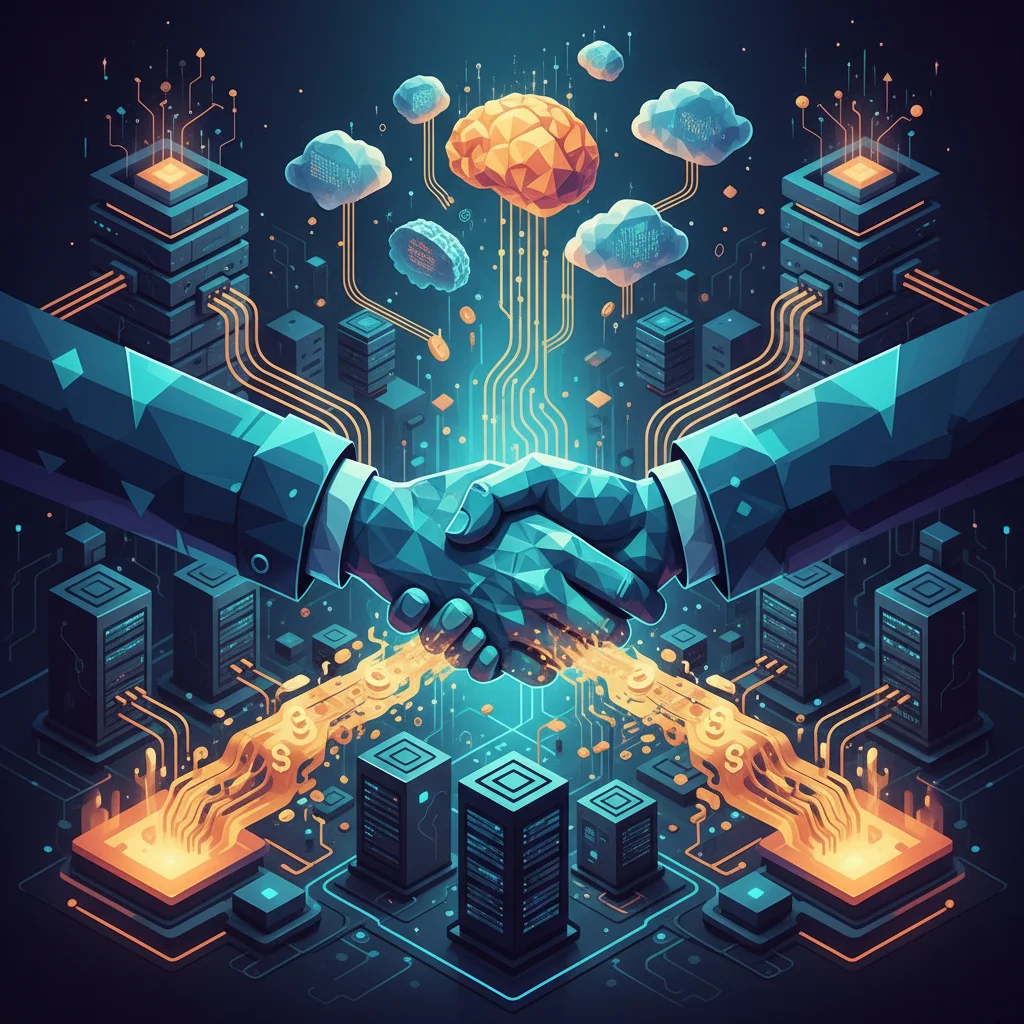
The $40 Billion Handshake: Why Tech Giants Are Pouring a Fortune into AI’s Physical Backbone
We talk a lot about artificial intelligence as a disembodied force—a ghost in the machine, a revolution in the cloud. We discuss algorithms, large language models, and the magic of generative AI. But what if the next giant leap in AI isn’t just about code, but about concrete, steel, and a colossal amount of electricity? A recent blockbuster deal suggests exactly that, and it’s a wake-up call for everyone in the tech world.
In a move that sends shockwaves through the technology and finance sectors, a powerhouse consortium including BlackRock, Global Infrastructure Partners (GIP), and Abu Dhabi’s MGX has orchestrated a staggering $40 billion takeover of Aligned Data Centers. And if that lineup wasn’t impressive enough, the buyers’ circle also includes the two companies at the very epicenter of the AI boom: Nvidia and Microsoft. This isn’t just another corporate acquisition; it’s a monumental bet on the physical infrastructure that will power the next decade of digital innovation.
This deal is about far more than real estate. It’s a strategic move to secure the picks and shovels for the AI gold rush, ensuring that the insatiable demand for computing power can be met. For developers, entrepreneurs, and tech leaders, understanding the “why” behind this $40 billion handshake is crucial for navigating the future of technology.
The A-Team of AI Infrastructure: Who’s Who in the Deal
To grasp the significance of this takeover, it’s essential to understand the players involved and their motivations. This isn’t a random collection of investors; it’s a strategically assembled team, each bringing a critical piece to the puzzle. The consortium’s goal is clear: to dramatically expand Aligned Data Centers’ capacity to handle the explosive growth in computing demand driven by artificial intelligence.
Here’s a breakdown of the key players and what they bring to the table:
| Company/Entity | Role & Strategic Interest |
|---|---|
| BlackRock & GIP | As two of the world’s largest infrastructure investors, their involvement signals that data centers are now considered a premier, long-term asset class, as critical as airports or power grids. They provide the financial muscle and expertise in large-scale infrastructure projects. |
| MGX | An Abu Dhabi-based AI and investment firm, their participation highlights the global race for AI supremacy. Sovereign wealth and national investment funds are aggressively securing computing resources as a matter of economic and strategic importance. |
| Nvidia | The undisputed king of AI hardware. Nvidia’s GPUs are the engines of the AI revolution. By investing in a data center provider, Nvidia is essentially investing in its biggest customer base, ensuring there are state-of-the-art facilities ready to house its next-generation chips. |
| Microsoft | A leader in cloud computing (Azure) and a primary partner of OpenAI. Microsoft’s demand for AI-ready data centers is almost limitless. This investment helps them secure a pipeline of the specialized infrastructure they need to grow their AI and SaaS offerings. |
| Aligned Data Centers | The prize itself. Aligned is known for its innovative and adaptable data center solutions, particularly in cooling and power efficiency—two of the biggest challenges in the AI era. They provide the physical foundation upon which this entire AI ecosystem will be built. |
This alliance is a masterclass in vertical integration. The chipmaker (Nvidia) and the primary software/cloud provider (Microsoft) are directly investing in the physical shells that will run their products. It’s a powerful move to de-risk their own growth trajectories.
Cybersecurity's Silent Crisis: Why Our Digital Guardians Are Burning Out (And How AI Can Help)
Why AI Has an Insatiable Appetite for Power and Space
So, why the sudden urgency to pour tens of billions into what are essentially massive, hyper-cooled warehouses? Because the data centers that powered the last decade of the internet are simply not equipped for the demands of large-scale machine learning.
Training a model like GPT-4 or generating a video with Sora requires a level of computational density that is orders of magnitude greater than streaming a movie or hosting a website. Here’s what makes AI data centers different:
- GPU Density: Traditional data centers are filled with CPUs (Central Processing Units) for general-purpose tasks. AI data centers are packed with thousands of GPUs (Graphics Processing Units), like Nvidia’s H100s, which are specialized for the parallel processing required by AI algorithms. These GPUs are power-hungry and generate immense heat.
- Extreme Power Consumption: A single rack of AI servers can draw over 100 kW of power, compared to 5-10 kW for a traditional rack. This puts an enormous strain on a facility’s electrical infrastructure and the local power grid. According to the International Energy Agency, data centers’ total electricity consumption could reach over 1,000 terawatt-hours by 2026, roughly equivalent to the entire electricity consumption of Japan (source).
- Advanced Cooling: The heat generated by these tightly packed GPUs cannot be managed by traditional air conditioning. This has spurred massive innovation in liquid cooling technologies, where fluids are circulated directly over the chips to dissipate heat more efficiently. It’s a complex engineering challenge that Aligned Data Centers is focused on solving.
In essence, this $40 billion deal isn’t just for buildings; it’s for highly specialized, power-intensive, and incredibly complex “AI factories” that are becoming the most valuable industrial real estate on the planet.
By investing in Aligned, Nvidia and Microsoft are not just customers; they are shaping their own supply chain. It’s a brilliant defensive and offensive move. Defensively, it helps guarantee they have the capacity they need, when they need it, preventing bottlenecks from slowing their growth. Offensively, it gives them influence over the design and operation of the very facilities that will showcase their technology’s power. Watch for this trend to accelerate. Controlling physical compute is fast becoming as important as writing brilliant code. The future of AI isn’t just in the cloud; it’s firmly tethered to the ground.
The Ripple Effect: What This Means for the Tech Ecosystem
A deal of this magnitude isn’t a contained event. Its shockwaves will be felt across the entire technology landscape, affecting everyone from individual developers to multinational corporations.
For Developers and Tech Professionals
The massive expansion of AI-ready infrastructure means more access to powerful computing resources. This could accelerate development cycles and enable the creation of even more sophisticated AI models. However, it also underscores the growing importance of efficient programming and model optimization. With compute costs remaining high, developers who can write code that minimizes resource usage will be incredibly valuable. Expertise in MLOps, distributed computing, and energy-efficient algorithms will be in high demand.
For Startups and Entrepreneurs
For startups, this is both a challenge and an opportunity. The challenge is clear: competing on foundational model building is now a game reserved for giants with deep pockets for infrastructure. The barrier to entry has been raised to stratospheric heights. However, the opportunity is immense. As the foundational layer solidifies, a whole new ecosystem of applications and services will be built on top. Think of specialized SaaS platforms that leverage powerful AI backends, tools for automation that manage complex AI workflows, or services that help companies optimize their AI spending on these massive cloud platforms.
Beyond the .5M Handshake: The AI and Code Behind YouTube's Content Battles
For Cybersecurity Professionals
The centralization of so much computing power into these mega data centers creates incredibly high-value targets. A successful attack on one of these facilities could disrupt services for millions and compromise sensitive data used in AI training. As a result, the demand for cutting-edge cybersecurity solutions tailored for AI infrastructure—from protecting data in transit during distributed training to securing the physical facilities themselves—will skyrocket. This is a critical growth area for security innovation.
The Road Ahead: Power, Politics, and a Planet in the Balance
While this investment signals a bright future for AI capabilities, it also brings significant challenges to the forefront. The most pressing issue is sustainability. The projected energy and water consumption of these AI factories is a serious environmental concern. The success of this expansion will depend heavily on innovations in energy efficiency and the ability to power these facilities with renewable energy sources. The industry’s carbon footprint is under intense scrutiny, and “building bigger” must be paired with “building smarter.”
Furthermore, the concentration of critical computing infrastructure in the hands of a few corporate and sovereign players has geopolitical implications. Access to AI compute is becoming a measure of national power, and this deal, with its mix of US and UAE interests, highlights the global nature of this competition (source). We are entering an era where digital sovereignty is intrinsically linked to data center sovereignty.
The End of Consulting as We Know It? Why Your Next Advisor Will Write Code, Not Just PowerPoints
In conclusion, the $40 billion acquisition of Aligned Data Centers is more than a headline-grabbing number. It is a physical manifestation of the AI revolution’s scale and a clear indicator of where the world’s most influential companies are placing their bets. They are betting on a future where the progress of software and digital intelligence is fundamentally limited by our ability to build and power its physical home. For all of us building that future, the message is clear: look to the ground, because that’s where the foundations of tomorrow’s cloud are being laid today.


